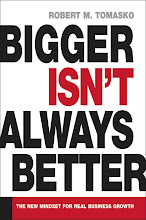December 09, 2008
Booms and busts
Richard Foster was a McKinsey director from 1982 to 2004, and is a coauthor of Creative Destruction. Here’s his take on the cyclical nature of growth cycles:
But happens in the aftermath of all the new regulations? Why don’t they seem to provide lasting relief?
Foster also thinks that our economy was “getting somewhat better at handling these cycles until 2000, but since then we’ve gotten worse.”
The key issue, of course, is: does it have to be this way? How can we move from a system that only fixes itself after another round of great pain to one that pulls us back way before we reach the brink? How can we cultivate the “good innovation” and minimize “the bad.”
Link
"During the boom times, when the equity premium goes way too high, everybody hocks everything to get in on the game, and this creates the conditions for a crash.
When the crash occurs, the politicians come in and say it was this or that person’s fault. Then they create regulatory institutions, and virtually every one of those institutions—starting with the Federal Reserve, in 1913, as a result of the crash of 1907—has been quite productive for the nation in the longer term. This includes the formation of the Securities and Exchange Commission, in 1934; the Investment Company Act, in 1940; the beginning of the end of fixed commission rates in 1970; and the Sarbanes–Oxley Act, in the early 2000s."
But happens in the aftermath of all the new regulations? Why don’t they seem to provide lasting relief?
“What do self-respecting entrepreneurs do when subjected to new regulations? They learn the regulations backward and forward and then vow never to start another business that falls within the scope of those regulations.
And so off the entrepreneur goes to find a new way. That’s one reason credit default swaps eventually took the form they did—the other options were regulated.
The new entrepreneur often seeks ways to innovate outside the scope of the newly established regulations. In the beginning, all that works out fine. We have innovations, we love the people who created them, they’re great heroes, the returns are strong, everybody says, ‘I’m going to be one of those guys.’
Eventually, all the truly good guys who are going to get into that business have done so. The opportunity starts drawing less savory figures—charlatans who overmarket, cut corners, establish usurious contracts, and do other clever things to generate profit for themselves. They end up bringing the system down.
Then guess what happens? At the end of that period, after the equity premium has soared and collapsed again, the government steps in and regulates the systems, this time focusing on the last wave of abuse.
And then we start over.”
Foster also thinks that our economy was “getting somewhat better at handling these cycles until 2000, but since then we’ve gotten worse.”
The key issue, of course, is: does it have to be this way? How can we move from a system that only fixes itself after another round of great pain to one that pulls us back way before we reach the brink? How can we cultivate the “good innovation” and minimize “the bad.”
Link
